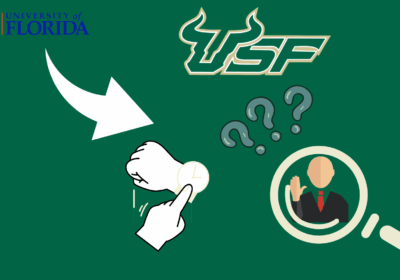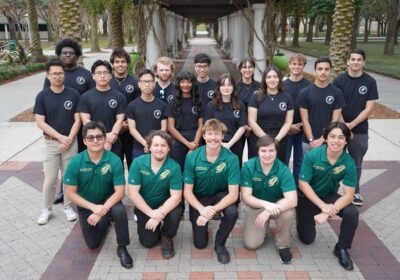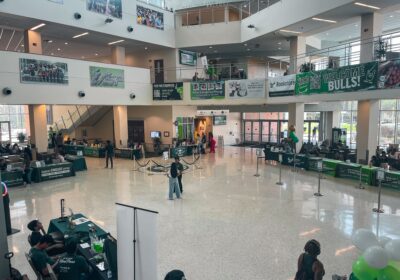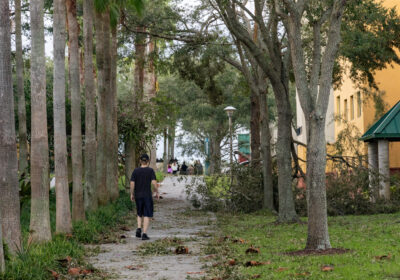USF Athletics’ budget gets slight cut for 2009-10
USF’s 2009-10 fiscal year athletics budget, which was released last week, is the second lowest among the 66 Bowl Championship Series (BCS) schools, said Executive Associate Athletic Director Bill McGillis.
The 2009-10 budget totals $32.2 million – a 0.8 percent cut from 2008-09 – and centers around seven revenue sources to help fund 17 teams and staffs.
Last year, USF’s budget totaled about $32.5 million, which included $200,000 earmarked for renovations made this summer to the Athletics Training Center.
Of the BCS schools, USF’s athletics budget is $10 million lower than the average of the other Big East Conference schools that participate in football, McGillis said.
Where does the athletics budget revenue come from?
The largest portion of the athletics department’s revenue comes from student fees, which will total $12,317,000 this year.
USF also receives funds from ticket sales, allocations from the Big East, development, corporate sponsorships, event revenue and football bowl games.
USF is estimating $5,355,000 in ticket sales in 2009-10, and football is projected to make up 87 percent of that figure, McGillis said.
“You can see how high ticket sales come from (football), and you can make a safe assumption that the vast majority of what we raise is related to football,” McGillis said. “A huge part of what we get from the Big East is football-related, so almost all of our
revenue streams are affected by football.”
The Big East will allocate $5,328,308 to USF this year. That number stems from the conference’s NCAA basketball tournament revenues, football bowl games and broadcasting contracts with ESPN and other media sources.
USF also brings in money for its own corporate contracts, including those with Bright House Sports Network, International Sports Properties and Under Armour for a total of $1,898,500.
A huge part of any athletics department is development, which centers around fundraising, endowment and money received from a university’s foundation, McGillis said. In the upcoming fiscal year, USF estimates an income of $2,576,800 in that area.
The last two funding sources are event revenues, which include concessions and merchandise, and football bowl game money. The combined estimate of these is $2,795,000.
Some of these sources are difficult to predict and budget for, McGills said, because they depend on ticket sales, which can differ from game to game, endowment intake and team success.
Last year, USF received $1.1 million for playing in the magicJack St. Petersburg Bowl. However, if the Bulls were to win the Big East and go to a BCS bowl game that number would increase significantly, McGillis said.
“The way most conferences work for bowl games is the money that all the schools bring in goes into a conference pool and then it gets redistributed back out to the schools,” he said. “Obviously, the BCS school gets a larger share.”
McGillis also said USF gets a good return in terms of athletics, considering how small a budget the University has compared to other BCS schools. He said Mississippi, Mississippi State and Baylor are other schools near the bottom in budgetary terms.
“We’re getting a lot of efficiency out of our budget,” he said. “We’re getting a lot of bang for our buck.”
Where is the money being spent?
Despite the slight cut in this year’s budget, USF Athletics increased its expenditures on compensation and fringe benefits for staff by $186,954 to a total of $12,373,954.
A majority of that increase is a $100,000 boost to football coach Jim Leavitt’s money pool for assistant coaches, which increases ever year as a built-in condition of the $12.6-million contract he signed in March of 2008.
“Football is without question the financial engine of our athletics department,” McGillis said. “I mean, it’s not even close. It’s driving the economic picture.”
The athletics department also increased its allocations for “game guarantee expenses” by nearly $400,000 and “administrative expenses” by about $150,000.
USF will spend about $1.79 million on game guarantee expenses, which are contracts the athletic department signs with other schools to entice them to play games at USF.
For football, the lowest amount USF pays to a visiting team this year is $150,000, which is the number for Big East games. The highest total is $450,000 for the Bulls’ home game against Charleston Southern on Sept. 19. McGillis said USF’s home game against in-state foe Miami on Nov. 28 will cost about $250,000 to $300,000.
The athletics department prefers to schedule home-and-home series with other schools rather than one-time games because it’s usually cheaper, McGillis said.
“For non-conference games, like when we play Florida State or Miami, you almost always – 99 percent of the time – you swap the exact same amount of money,” he said. “When it’s a one-time deal, you pay more to get that school to come to your place even though you won’t be going to their place.”
With the increase in some areas of the budget, the athletics department cut a total of $781,206 from other sections.
The departments that received cuts were the Athletic Training Center, external relations, which includes marketing and sports information, grant-in-aid scholarship money, reserve funds and traveling costs.
USF also reduced the amount of money it will pay to the USF Foundation for a loan the athletics department was given when the football program was implemented nearly 13 years ago, McGillis said.
Each year, the athletics department makes payments to the foundation to pay off the loan. Last year, USF paid $154,994. This year, the number drops to $41,677.
Other reductions come from moving media guides exclusively online rather than printing them and traveling by bus instead of plane to Tallahassee for the football team’s matchup with Florida State on Sept. 26.
When asked about USF’s plans for an athletics district, McGillis said the athletics department is fully committed on “a daily basis” to adding to the football and basketball practice facilities, as well as renovating the baseball and softball stadiums.
There is no money allocated to any athletics district projects, according to the 2009-10 fiscal year budget.
Despite the slight budget cut this year, and USF’s smaller pool of money compared to other BCS schools, McGills said the athletics department will continue to grow because of its efficiency.
“It’s all about (USF Athletic Director) Doug Woolard’s effort – our coaches who are very budget consciences and a lot of hard work by a lot of people,” he said. “Sometimes the salaries in intercollegiate athletics grab the headlines, but it’s important to understand the context of where our budget is compared to the competition.”







